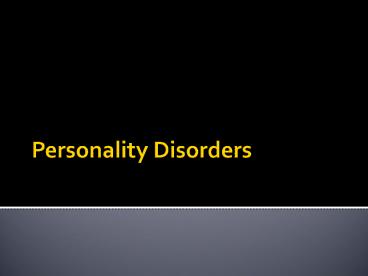Personality Disorders - PowerPoint PPT Presentation
1 / 12
Title: Personality Disorders
1
Personality Disorders
2
- I pulled up near a gas station. I told the
service station guy to give me all of his money.
I then took him to the bathroom and told him to
kneel down and then I shot him in the head twice.
The guy didnt give me any trouble but I just
felt like I had to do it. The next morning, I
left my car at another service station I went in
and told the guy to give me the moneyThen I shot
him.
3
Definition
- Personality disorder psychological disorder
characterized by inflexible and enduring behavior
patterns that impair social functioning. - Dysfunctional behavior patterns that impair
peoples social functioning without depression or
delusions.
4
Symptoms
- Personality disorders symptoms
- Ego syntonic feels like a normal part of
oneself - Most have interpersonal problems
- Can be difficult to diagnose in initial session
- Difficult to treat can affect treatment of
other disorders
5
Cluster Organization in DSM-IV
- Personality disorders are classified within
clusters defined by common features - Cluster A
- Main feature is odd or eccentric in nature
- Within this cluster
- Paranoid PD distrust and suspiciousness
- Schizoid PD detachment from social
relationships (does not want them) - Schizotypal PD feels intense discomfort in
close relationships has distorted thinking and
eccentric behavior.
6
Clusters (cont.)
- 2) Cluster B
- Main feature is dramatic, emotional, or erratic
- Within this cluster
- Antisocial PD disregard for social norms and
rights of others - Borderline PD instability in relationships,
self-image, and mood impulsive - Histrionic PD excessive emotionality and
attention seeking - Narcissistic PD elaborate, need for admiration,
self-centered
7
Clusters (cont.)
- 3) Cluster C
- Main feature involves anxiety or fearfulness
- Within this cluster
- Dependent PD submissive, need to be taken care
of - Avoidant PD social inhibition and inadequacy
- Obsessive-Compulsive PD orderliness,
perfectionism, need to control things
8
Antisocial Personality Disorder
- Formerly called a sociopath or psychopath
- Usually male
- Lack of conscience becomes plain before age 15
- Common characteristics
- Superficial charm
- Absence of delusions and irrational thinking
- Absence of nervousness
- Unreliability
- Untruthfulness and insincerity
- Lack of remorse or shame
- Poor judgment and failure to learn by experience
- Incapable of love
- Unresponsiveness in general interpersonal
relations - Sex life impersonal and trivial
- Failure to follow any life plan
9
Antisocial vs. Criminal Behavior
- Criminal is a legal term denoting conviction
for breaking a law - Not all people with ASPD are criminals (or in
jail) - Not all people in jail or considered criminals
have ASPD - Many criminals do show responsible concern for
their family and friends. - Antisocial personalities feel and fear little.
10
Serial Killers
- Jeffrey Dahmer
- Killing spree 1978-1991 of 17 known
- men boys.
- Murders involved rape,
- dismemberment, cannibalism, necrophilia.
- Henry Lee Lucas
- 32 years of crime
- Confessed to killing 360 women,
- men, and children.
- Murders involved beating,
- suffocation, shooting, and stabbing
11
Nature vs. Nurture
- Biological
- -Twin, family, and adoption data show strong
genetic influence - - Show little autonomic nervous system arousal
is stressful situations - -Violent repeat offenders have 11 less frontal
lobe tissue than normal. - Neither bad genes alone nor a bad environment
alone predispose later antisocial behavior. - -Nature vs. Nurture interact
- Antisocial behavior seems to age out after 40
- - could still show ASPD features (lying poor
work habits)
12
Treatment
- Most dont seek treatment for ASPD
- No treatment shown to be effective
- More likely to end up in jail than in treatment
- Focus is on prevention
- Target antisocial children channel
characteristics (fearfulness, low anxiety) into
positive roles - athletics, adventure, military































